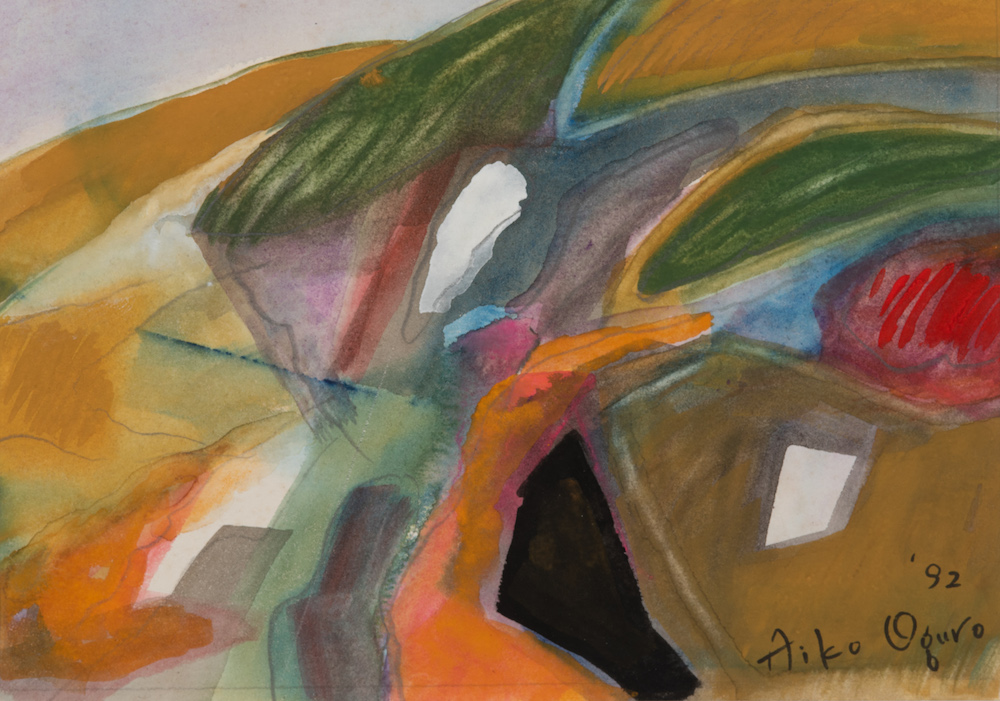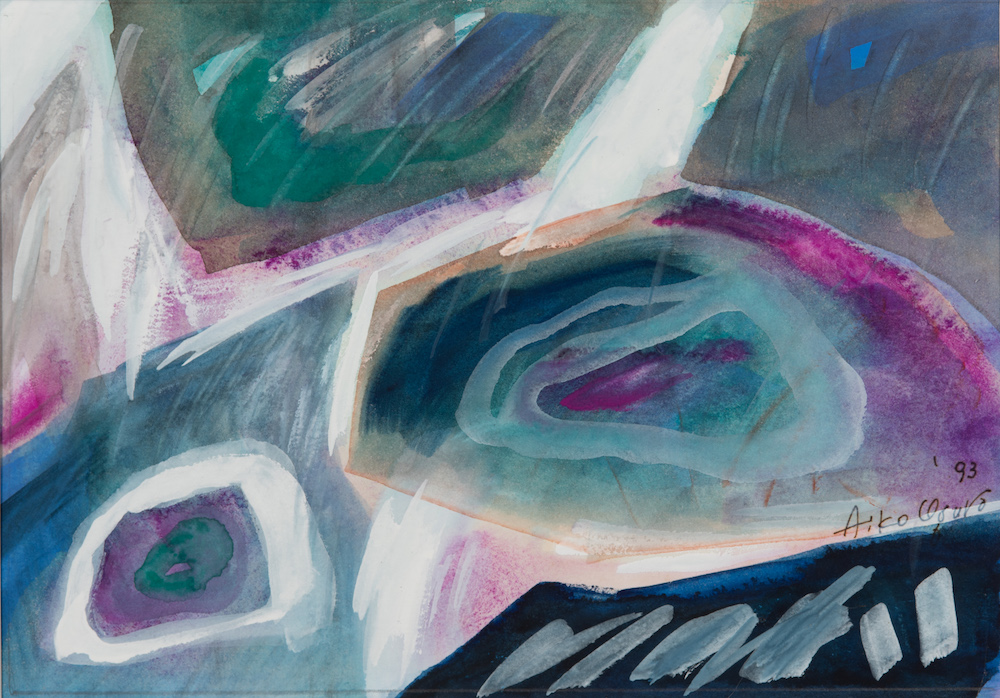Aiko OGURO

【Japanese】
Aiko Oguro
1937年、福岡市に生まれる。郵便局員であった父の転勤にともない満州長春へ移住。
昭和30年(1955)福岡雙葉学園高等部洋裁科卒業。
寺田健一郎に洋画を学び、前衛芸術家集団九州派に加入、読売アンデパンダン展に出品。
九州派に参加後、1960年当時流行したアンフォルメル風の油彩を描く。機関誌『九州派 4』に会員として名前が記載された。
以後大黒は、先輩格の田部とともに、女性画家としては最後まで九州派に留まった。
1960年、福岡市小戸に小幡英資との共同自宅アトリエで画塾を開き、以後晩年まで児童の絵画教育に取り組む。
1961年の九州派展(銀座両廊)には、皿を貼った絵画を出品した。
1963年の九州派展にも円形の皿状の物を整然と並べて貼り付けた絵画(オッパイという作品?)を出品。
1965年、最後の九州派展 には(性器の絵画)を出品した。
田部光子の(人工船盤)などを先駆けとして、大黒もストレートなタイトルで、女性の肉 体への男性のエロティックなまなざしを批評的に表現したのだろう
。
1974年、元九州派の田部光子とともに九州女流画家展を創設。
没後、「前衛の女性 1950-1975」(栃木県立美術館、平成17年)に取り上げられるなど、戦後日本前衛美術において名を残す数少ない女性作家の一人である。
「ある作品に見た女性と私の作品について」
気狂い女が踊りながら通る。
その面立ちはもう人間の顔ともおもわれずはいえなのように、かわいた笑い声をたてている。
ばらばらな文句の切れ端を口から出まかせにしゃべり、ポプラの葉のように前に前にと歩いてゆく、
砕けた知性の霜をとおして無意識な能力の渦巻のなかにそれを時々かいまみているだけなのだ。
生れついた優しさも美しさもみんな失い足どりもはしたなく、臭い息をしている。
この地上で幸福なことがあるとすれば、その時は驚いてもいいだろう臭い息をしている。
しかし気狂い女は非難ひとつしない。
身を嘆き訴えるにはあまりに誇り高く彼女に興味をもつ者たちに言葉をかけられるのを決して許さなかった。
そして、その秘密をあかさないままで死んでゆくであろう。神の摂理はいかにかと?
大黒愛
1958年から洋画家寺田健一郎に師事する。寺田が 1957 年末から九州派に参加したため、大黒も九州派を知るようになる。
1958年 第14回福岡県美術展に絵画2点入選。しかし、この県展の審査員と審査方法に対して九州派23名が抗議書を提出した。
1959年 第2回九州アンデパンダン展に《流れるもの》出品。
1959年 公募展出品を巡って会員が対立し、二科展に出品を続けた師の寺田が九州派を脱会。大黒は田部光子とともに寺田を説得するが、寺田は復帰しなかった。
1960年 第12回読売アンデバンダン展に 《芯》(cat.no.104)を出品(以後 15 回まで出品を続ける)。この頃は当時流行したアンフォルメル風の油彩を描く。
1960年、第1回全九州アンデパンダン展に出品。九州派に参加する。
1961年に発行された機関誌『九州派 4』に会員として名前が記載された。以後大黒は、先輩格の田部とともに、女性画家としては最後まで九州派に留まった。
1961年の九州派展(銀座画廊)には、皿を貼った絵画を出品した。
1963年の九州派展にも円形の皿状の物を整然と並べて貼り付けた絵画(<オッパイ>という作品?)を出品。同年の九州派展に<オッパイ絵画>で参加
1965年、最後の九州派展 には《性器の絵画)を出品した。田部光子のく人工船盤》や(ブラカード)を先駆けとして、大黒もストレートなタイトルで、女性の肉体への男性のエロティックなまなざしを批評的に表現したのだろう
1980年、第1回小戸物産展(福岡)
1983年、県政刷新をアピールする作家展(福岡)
1984年、福岡市西区役所ロビー壁画制作に参加第
1992年、ギャラリーおいし個展(福岡)ギャラリーおいし個展(福岡)
1993年、由布院空想の森美術館個展
1995年、永眠
【English】
Born in Fukuoka City in 1937.
Moved to Changchun, Manchuria, when her father, a post office worker, was transferred there.
Graduated from Fukuoka Futaba Gakuen High School in 1955.
Studied Western-style painting Terada Kenichiro, joined the avant-garde artists’ group Kyushu-Ha, and exhibited at the Yomiuri Independents Exhibition.
In 1935, she opened an art school in her home studio with Hidesuke Obata in Odo, Fukuoka City, where she continued to teach painting to children until her later years.
In 1949, she founded the Kyushu Women Painters Exhibition with Mitsuko Tabe, a former member of Kyushu-Ha.
After leaving the group, she organized the “Odo Products Exhibition” with Hidesuke Obata.
In 1993, held a solo exhibition at the Yufuin Soranomori Museum of Art.
After her death, she was featured in the exhibition “Women of the Avant-garde 1950-1975” (Tochigi Prefectural Museum of Fine Arts, 2005), and is one of the few female artists who remain prominent in the postwar Japanese avant-garde art scene.
(From Fukuoka Prefectural Museum of Art web site)
From 1958, she studied under the Western-style painter Kenichiro Terada. Since Terada joined the Kyushu-Ha from the end of 1957, Oguro also came to know the Kyushu-Ha.
In 1958, two paintings were selected for the 14th Fukuoka Prefectural Art Exhibition. However, 23 members of the Kyushu-Ha submitted a letter of protest against the judges and judging methods of this prefectural exhibition.
1959: “Flowing Things” was exhibited at the 2nd Kyushu Independents Exhibition.
1959: Due to a conflict among members over exhibiting at public exhibitions, Terada, who had continued to exhibit at the Nika Exhibition, withdrew from Kyushu-Ha. Oguro and Mitsuko Tabe tried to persuade Terada, but he did not return.
In 1960, Oguro exhibited “Core” (cat. no.104) at the 12th Yomiuri Independents Exhibition (and continued to exhibit it until the 15th exhibition). At that time, she painted oil paintings in the style of enformel, which was popular at the time.
In 1960, she participated in the 1st All Kyushu Independents Exhibition. She joined the Kyushu-Ha.
Her name was listed as a member in the journal “Kyushu-ha 4” published in 1961. From then on, Oguro, along with her senior colleague Tabe, remained with the Kyushu-ha until the end of her career as a female painter.
In 1961, she exhibited a painting with plates pasted on it at the Kyushu-ha Exhibition (Ginza garou).
In 1963, she also exhibited a painting called “Oppai” (boobs?), in which she pasted circular plate-like objects in an orderly arrangement, at the 1963 Kyushu-ha exhibition. In the same year, she exhibited a painting called
In 1965, she exhibited “Genitalia Painting” at the last exhibition of the Kyushu-Ha. As a forerunner of Mitsuko Tabe’s “Artificial Boat Disc” and “Brackard,” Oguro also used a straightforward title to critically express the erotic gaze of men on the female body.
1980, The 1st Koto Products Exhibition (Fukuoka)
1983, Artists’ Exhibition Appealing for Renewal of Prefectural Government (Fukuoka)
1984, Participated in the mural painting in the lobby of Fukuoka City’s Nishi Ward Office (Fukuoka)
1992, Gallery Oishi Solo Exhibition (Fukuoka), Gallery Oishi Solo Exhibition (Fukuoka)
1993, Yufuin Soronomori Museum of Imagination solo exhibition
1995, Permanent rest
<美術館コレクション Museum collection>
福岡県立美術館 →大黒愛子収蔵作品

「non title」
oil on paper
150×210/1993

「由布院の四季」
oil on paper
150×210/1993
【Article Japanese】
西日本新聞 文化欄 前衛たちの軌跡 九州派から四半世紀 1988年 article